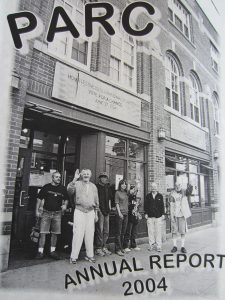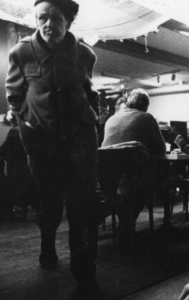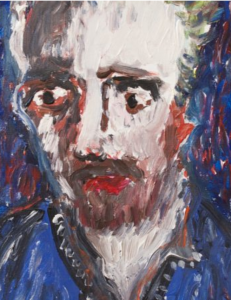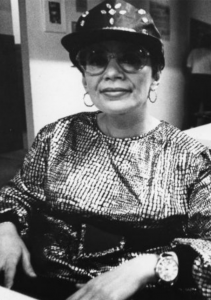A Living Room to Thousands: Wellbeing at PARC Unit
 Takeaways
Takeaways
- Appreciate that healthy living includes access to safe egalitarian spaces where sociability, privacy, creative self-expression, and the necessities of daily living are available to people as citizens
- Understand the importance of the drop-in style, member-driven programming, and self-directed services in community services
- Appreciate the therapeutic role of using personal voice and storytelling through art and writing in fostering positive identity, social inclusion, and intellectual and political engagement
- Describe best practice in community mental health
 Components
Components
The photographic and textual components in this unit are reminders of the importance of healthy home spaces: familiar art on the walls, good food on our plates at mealtimes, meaningful activities for us to do. People with secure homes tend to take these things for granted, but this unit makes clear their importance for members of PARC, a Toronto Drop-In and community hub.
These are just a sample of our PARC components: educators and students can find the whole set in Components: Art Self-Guided, Components: Food Self-Guided and Components: Place Self-Guided.
 Evaluating the Components
Evaluating the Components
- Components: Art Self Guided – 30 minutes
- Component Evaluation: Art Sound Bite – 15 minutes
- Component Evaluation: Art Multi-purpose – 30 minutes
- Components: Food Self Guided – 15 minutes
- Components: Place Self Guided – 30 minutes
- Components: Place Discussion – 15 minutes
- Components: Place Short Paper – 15 minutes
 Learning Lens
Learning Lens
When PARC (Parkdale Activity Recreation Centre) was founded in 1980, it was envisioned as a haven, a sanctuary from the outside world for those who needed it most: deinstitutionalized psychiatric patients who were not welcomed elsewhere in Toronto’s Parkdale neighbourhood. More than forty years on, PARC remains a space of hope and wellbeing for many, but it is also recognized as a vital civic institution, part of the fabric that makes Parkdale a unique Toronto community.
Throughout its history, PARC’s Drop-In has been a “living room to thousands.” This is crucial because many members don’t have homes with safe, comfortable and welcoming spaces to be social or solitary. For many who come to PARC, having a living room is something that most people take for granted, but a safe and comfortable place to be with friends and family or find solitude is an unattainable luxury. A “living room” is a space for daily pursuits like eating, socializing, seeking solitude and finding creativity. All of these are activities of wellbeing, and build toward the core capacities of PARC’s Drop-In model: personal health and safety, identity, social relationships. What is also critically important at the PARC Drop-In is that it is a space that belongs to its members, a place where they are not patients or client, but citizens.
A Living Room to Thousands: Well-being at PARC offers a past/present perspective to help future mental health practitioners appreciate how one organization evolved as it worked to meet the needs of its members. Creativity and self-expression, food and hanging out are the focus topics in these resources, but the politics of citizenship and the theme of wellbeing through personal health and safety, identity and social relationships underscore every facet of PARC’s Drop-In. Instructors can use the PARC resources to look at specific facets of wellbeing at the PARC Drop-In or to help students think more broadly and empathetically about the life world of PARC members and to consider the importance of citizenship.
Exploring these central aspects of the PARC Drop-In – creativity, food and hanging out – this unit takes learners into the world of PARC, helping them appreciate the importance of spaces that nurture wellbeing and foster hope.
Instructors and learners may wish to make use of PARC’s model of the Core Drop-In Capacities. Note the importance placed on basic human needs, social engagement, and a valid sense of self in this key PARC document, a best practice model for running drop-in facilities created by longtime PARC worker Bob Rose.
 Components in Context
Components in Context
Parkdale, once a thriving and trendy middle-class Toronto neighbourhood, became a place of boarding houses and bachelorettes in the years following World War Two. By 1979 Lakeshore Psychiatric Hospital, about twelve kilometers west, had closed its doors and the nearby Queen Street Mental Health Centre had drastically reduced in-patient beds. Sandwiched midway between these two facilities, and a first destination for many former patients seeking housing, Parkdale was heavily impacted by the push to deinstitutionalize mental health care.
Contrary to claims made by advocates of community care, Parkdale did not ‘make room’ for those set adrift from the big hospitals, or provide them with safe, adequate, or healthy ways of living. Former patients found themselves trying to make do with inadequate welfare payments and poor levels of outside support. Their often-obvious poverty, marginal living situations, and psychiatric diagnoses bred suspicion and distrust among Parkdale’s middle-class. The media fuelled these fears with stories of decreasing property values, dangerous streets, and the emergence of Parkdale as a “Psychiatric Ghetto” or a “Dumping ground for social misfits.”
PARC emerged in 1980 as a trusted retreat for Parkdale residents whose lives had been battered by mental health difficulties, providing safety, conversation, food and coffee. When it first opened its doors in 1980, PARC was a small facility with a TV lounge, a pool table, and a seating area. Furniture was salvaged from the basement of the Lakeshore Psychiatric Hospital, which had closed the previous year. A small kitchen allowed members to cook meals for themselves. Over time, the Drop-In grew to include a coffee bar, a small stage, a piano, laundry facilities, a tool-lending library, computer and cooking classes, a Friday community meal program, and a writing group. To PARC members that were under-housed or homeless, living in boarding homes, rooming houses, or on the streets, PARC offered a space that could feel like a home – a place to be creative, learn new skills, chat with friends, or grab a meal or coffee. Equally important, PARC’s living room offered members a space to be quiet and be alone, where they could relax and exercise their right to not participate. PARC was and continued to be a lively communal living room, filled with the bodies (sitting, eating, active) and sounds (voices, the clunk of pool cues, music) of members, its walls decorated with member art, crafts and photographs.

Over time, PARC became a space that fostered community, creativity, positive identities, personal wellbeing, and new political understandings of the discrimination faced by service users. Inside the doors of 1499 Queen Street West, PARC members were not “patients,” but artists, citizens, employees, writers and activists. Using PARC’s resources and their own creative and productive energies, members present different narratives from those espoused by newspapers, psychiatrists, police and property owners. Today, poetry, art and conversation shift through the doors of PARC onto neighbouring streets. Pageants, exhibits and useful resources like PARC’s tool-lending library bring the larger Parkdale community to PARC. Journalists report on PARC’s art and events, its housing and employment services, and its involvement in various advocacy roles. PARC members have claimed Parkdale as their own and Parkdale has come to accept PARC as an important part of the community.
Members know that the Drop-In is their space, and those who have been around for a while recall the wafting cigarette smoke that used to permeate the place. This communal ownership rests on the fact that, from the beginning, PARC was as a non-medicalized space for self-directed activity, learning, and recreational opportunities. A committee made up of elected PARC members, responsible for programming, activities, and events, ensures that PARC programming is driven by the wishes and needs of its membership.
Of course, this is not a simple story of progressive change in the era of community mental health. Stigma continues. Discrimination remains and the equality gap grows across Toronto. But the PARC Drop-In continues as an inspiring practice model that works well for both its members and the broader Parkdale community.
Please Note: We have attempted to identify the individuals whose images are displayed on these pages. However, we know this is an imperfect process. If you can help us identify unnamed individuals, or if you want us to remove an image from this site, please let us know and we will make the necessary changes.





 Français
Français